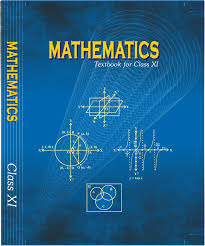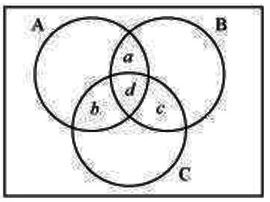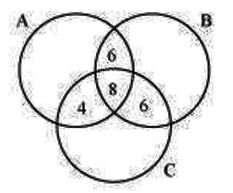Class 11 - Mathematics
Sets - Exercise - Misc

Top Block 1
Question 1:
Decide, among the following sets, which sets are subsets of one and another:
A = {x : x ∈ R and x satisfy x2– 8x + 12 = 0}, B = {2, 4, 6}, C = {2, 4, 6, 8, . . .}, D = {6}.
Answer:
A = {x: x ∈ R and x satisfies x2– 8x + 12 = 0}
Now, x2 – 8x + 12 = 0
⇒ x2 – 2x – 6x + 12 = 0
⇒ x(x – 2) – 6(x – 2) = 0
⇒ (x – 2)(x – 6) = 0
⇒ x = 2, 6
So, 2 and 6 are the only solutions of x2 – 8x + 12 = 0.
Hence, A = {2, 6}
B = {2, 4, 6},
C = {2, 4, 6, 8 …},
D = {6}
So, D ⊂ A ⊂ B ⊂ C
Hence, A ⊂ B, A ⊂ C, B ⊂ C, D ⊂ A, D ⊂ B, D ⊂ C
Question 2:
In each of the following, determine whether the statement is true or false. If it is true, prove it. If it is false, give an example.
(i) If x ∈ A and A ∈ B, then x ∈ B
(ii) If A ⊂ B and B ∈ C, then A ∈ C
(iii) If A ⊂ B and B ⊂ C, then A ⊂ C
(iv) If A ⊄ B and B ⊄ C, then A ⊄ C
(v) If x ∈ A and A ⊄ B, then x ∈ B
(vi) If A ⊂ B and x ∉ B, then x ∉ A
Answer:
(i) False.
Let A = {1, 2} and B = {1, {1, 2}, {3}}
Now, 2 ∈ {1, 2} and {1, 2} ∈ {1, {1, 2}, {3}}
Hence, A = B
However, 2 ∉ {1, {1, 2}, {3}}
(ii) False.
Let A = {2}, B = {0, 2} and C = {1, {0, 2}, {3}}
As A ⊂ B and B ⊂ C
However, A ∉ C
(iii) True.
Let A ⊂ B and B ⊂ C.
Let x ∈ A
⇒ x ∈ B [Since A ⊂ B]
⇒ x ∈ C [Since B ⊂ C]
So, A ⊂ C
(iv) False.
A = {1, 2}, B = {0, 6, 8} and C = {0, 1, 2, 6, 9}
Let A ⊄ B and B ⊄ C
Accordingly,
However, A ⊂ C
(v) False.
Let A = {3, 5, 7} and B = {3, 4, 6}
Now, 5 ∈ A and A ⊄ B
However, 5 ∉ B
(vi) True.
Let A ⊂ B and x ∉ B.
To show: x ∉ A
If possible, suppose x ∈ A.
Then, x ∈ B, which is a contradiction as x ∉ B
So, x ∉ A
Question 3:
Let A, B, and C be the sets such that A ∪ B = A ∪ C and A ∩ B = A ∩ C. Show that B = C.
Answer:
Let, A, B and C be the sets such that A ∪ B = A ∪ C and A ∩ B = A ∩ C.
To show: B = C
Let x ∈ B
⇒ x ∈ A U B [B ⊂ A U B]
⇒ x ∈ A U C [A U B = A U C]
⇒ x ∈ A or x ∈ C
Case 1: x ∈ A
Also, x ∈ B
So, x ∈ A ∩ B
⇒ x ∈ A ∩ C [Since A ∩ B = A ∩ C]
⇒ x ∈ A and x ∈ C
So, x ∈ C
Hence, B ⊂ C
Similarly, we can show that C ⊂ B.
So, B = C
Question 4:
Show that the following four conditions are equivalent:
(i) A ⊂ B (ii) A – B = φ (iii) A ∪ B = B (iv) A ∩ B = A
Answer:
First, we have to show that (i) ⇔ (ii).
Let A ⊂ B
To show: A – B ≠ φ
If possible, suppose A – B ≠ φ
This means that there exists x ∈ A, x ≠ B, which is not possible as A ⊂ B.
∴ A – B = φ
∴ A ⊂ B ⇒ A – B = φ
Let A – B = φ
To show: A ⊂ B
Let x ∈ A
Clearly, x ∈ B because if x ∉ B, then A – B ≠φ
∴ A – B = φ ⇒ A ⊂ B
So, (i) ⇔ (ii)
Let A ⊂ B
To show: A U B = B
Clearly, B ⊂ A U B
Let x ∈ A U B
Case 1: x ∈ A
⇒ x ∈ B [Since A ⊂ B]
So, A U B ∈ B
Case 2: x ∈ B
Then, A U B = B
Conversely, let A U B = B
Let x ∈ A
⇒ x ∈ A U B [Since A ⊂ A U B]
⇒ x ∈ B [Since A U B = B]
So, A ⊂ B
Hence, (i) ⇔ (iii)
Now, we have to show that (i) ⇔ (iv).
Let A ⊂ B
Clearly A ∩ B ⊂ A
Let x ∈ A
We have to show that x ∈ A ∩ B
As A ⊂ B, x ∈ B
So, x ∈ A ∩ B
⇒ A ⊂ A ∩ B
Hence, A = A ∩ B
Conversely, suppose A ∩ B = A
Let x ∈ A
⇒ x ∈ A ∩ B
⇒ x ∈ A and x ∈ B
⇒ x ∈ B
So, A ⊂ B
Hence, (i) ⇔ (iv).
Question 5:
Show that if A ⊂ B, then C – B ⊂ C – A.
Answer:
Let A ⊂ B
To show: C – B ⊂ C – A
Let x ∈ C – B
⇒ x ∈ C and x ∉ B
⇒ x ∈ C and x ∉ A [Since A ⊂ B]
⇒ x ∈ C – A
Hence, C – B ⊂ C – A
Question 6:
Assume that P(A) = P(B). Show that A = B
Answer:
Let P(A) = P(B)
To show: A = B
Let x ∈ A
A ∈ P(A) = P(B)
Hence, x ∈ C, for some C ∈ P(B)
Now, C ⊂ B
So, x ∈ B
Hence, A ⊂ B
Similarly, B ⊂ A
So, A = B
Question 7:
Is it true that for any sets A and B, P(A) ∪ P(B) = P(A ∪ B)? Justify your answer.
Answer:
It is false.
Let A = {0, 1} and B = {1, 2}
Now, A ∪ B = {0, 1, 2}
P(A) = { φ, {0}, {1}, {0, 1}}
P(B) = { φ, {1}, {2}, {1, 2}}
P(A ∪ B) = { φ, {0}, {1}, {2}, {0, 1}, {1, 2}, {0, 2}, {0, 1, 2}}
P(A) ∪ P(B) = { φ, {0}, {1}, {0, 1}, {2}, {1, 2}}
So, P(A) ∪ P(B) ≠ P(A ∪ B)
Question 8:
Show that for any sets A and B,
A = (A ∩ B) ∪ (A – B) and A ∪ (B – A) = (A ∪ B)
Answer:
To show: A = (A ∩ B) ∪ (A – B)
Let x ∈ A
We have to show that x ∈ (A ∩ B) ∪ (A – B)
Case 1: x ∈ A ∩ B
Then, x ∈ (A ∩ B) ⊂ (A ∪ B) ∪ (A – B)
Case 2: x ∉ A ∩ B
⇒ x ∉ A or x ∉ B
⇒ x ∉ B [x ∉ A]
⇒ x ∉ A – B ⊂ (A ∪ B) ∪ (A – B)
So, A ⊂ (A ∩ B) ∪ (A – B) ………. (1)
It is clear that
A ∩ B ⊂ A and (A – B) ⊂ A
So, (A ∩ B) ∪ (A – B) ⊂ A …….. (2)
From equation (1) and (2), we obtain
A = (A ∩ B) ∪ (A – B)
To prove: A ∪ (B – A) ⊂ A ∪ B
Let x ∈ A ∪ (B – A)
⇒ x ∈ A or x ∈ (B – A)
⇒ x ∈ A or (x ∈ B and x ∉ A)
⇒ (x ∈ A or x ∈ B) and (x ∈ A or x ∉ A)
⇒ x ∈ (A ∪ B)
So, A ∪ (B – A) ⊂ (A ∪ B) ………. (3)
Next, we show that (A ∪ B) ⊂ A ∪ (B – A).
Let y ∈ A ∪ B
⇒ y ∈ A or y ∈ B
⇒ (y ∈ A or y ∈ B) and (y ∈ A or y ∉ A)
⇒ y ∈ A or (y ∈ B and y ∉ A)
⇒ y ∈ A ∪ (B – A)
So, A ∪ B ⊂ A ∪ (B – A) ………. (4)
Hence, from equation (3) and (4), we get
A ∪ (B – A) = A ∪ B.
Question 9:
Using properties of sets, show that
(i) A ∪ (A ∩ B) = A (ii) A ∩ (A ∪ B) = A.
Answer:
(i) To show: A ∪ (A ∩ B) = A
We know that
A ⊂ A
A ∩ B ⊂ A
So, A ∪ (A ∩ B) ⊂ A …….. (1)
Also, A ⊂ A ∪ (A ∩ B) ……. (2)
Now, from equation (1) and (2), we get
A ∪ (A ∩ B) = A
(ii) To show: A ∩ (A ∪ B) = A
A ∩ (A ∪ B) = (A ∩ A) ∪ (A ∩ B) = A ∪ (A ∩ B) = A [from equation (1)]
Mddle block 1
Question 10:
Show that A ∩ B = A ∩ C need not imply B = C.
Answer:
Let A = {0, 1}, B = {0, 2, 3}, and C = {0, 4, 5}
Accordingly, A ∩ B = {0} and A ∩ C = {0}
Here, A ∩ B = A ∩ C = {0}
However, B ≠ C [Since 2 ∈ B and 2 ∉ C]
Question 11:
Let A and B be sets. If A ∩ X = B ∩ X = φ and A ∪ X = B ∪ X for some set X, show that A = B. (Hints A = A ∩ (A ∪ X) , B = B ∩ (B ∪ X) and use Distributive law)
Answer:
Let A and B be two sets such that A ∩ X = B ∩ X = f and A ∪ X = B ∪ X for some set X.
To show: A = B
It can be seen that
A = A ∩ (A ∪ X)
= A ∩ (B ∪ X) [Since A ∪ X = B ∪ X]
= (A ∩ B) ∪ (A ∩ X) [Distributive law]
= (A ∩ B) ∪Φ [Since A ∩ X = φ]
= A ∩ B ……….. (1)
Now, B = B ∩ (B ∪ X)
= B ∩ (A ∪ X) [Since A ∪ X = B ∪ X]
= (B ∩ A) ∪ (B ∩ X) [Since Distributive law]
= (B ∩ A) ∪φ [Since B ∩ X = φ]
= B ∩ A
= A ∩ B ……………(2)
From equation (1) and (2), we get
A = B.
Question 12:
Find sets A, B and C such that A ∩ B, B ∩ C and A ∩ C are non-empty sets and A ∩ B ∩ C = φ.
Answer:
Let A = {0, 1}, B = {1, 2}, and C = {2, 0}.
Accordingly,
A ∩ B = {1}, B ∩ C = {2}, and A ∩ C = {0}.
So, A ∩ B, B ∩ C, and A ∩ C are non-empty.
However, A ∩ B ∩ C = φ
Question 13:
In a survey of 600 students in a school, 150 students were found to be taking tea and 225 taking coffee, 100 were taking both tea and coffee.
Find how many students were taking neither tea nor coffee?
Answer:
Let U be the set of all students who took part in the survey.
Let T be the set of students taking tea.
Let C be the set of students taking coffee.
Accordingly, n(U) = 600, n(T) = 150, n(C) = 225, n(T ∩ C) = 100
To find: Number of student taking neither tea nor coffee i.e.,
we have to find n(T’ ∩ C’).
n(T’ ∩ C’) = n(T ∪ C)’
= n(U) – n(T ∪ C)
= n(U) – [n(T) + n(C) – n(T ∩ C)]
= 600 – [150 + 225 – 100]
= 600 – [375 – 100]
= 600 – 275
= 325
Hence, 325 students were taking neither tea nor coffee.
Question 14:
In a group of students, 100 students know Hindi, 50 know English and 25 know both. Each of the students knows either Hindi or English.
How many students are there in the group?
Answer:
Let U be the set of all students in the group.
Let E be the set of all students who know English.
Let H be the set of all students who know Hindi.
So, H ∪ E = U
Accordingly, n(H) = 100 and n(E) = 50
n(H U E) = n(H) + n(E) – n(H ∩ E)
= 100 + 50 – 25
= 150 – 25
= 125
Hence, there are 125 students in the group.
Question 15:
In a survey of 60 people, it was found that 25 people read newspaper H, 26 read newspaper T, 26 read newspaper I,
9 read both H and I, 11 read both H and T, 8 read both T and I, 3 read all three newspapers. Find:
(i) the number of people who read at least one of the newspapers.
(ii) the number of people who read exactly one newspaper.
Answer:
Let A be the set of people who read newspaper H. Let B be the set of people who read
newspaper T. Let C be the set of people who read newspaper I.
Accordingly,
n(A) = 25, n(B) = 26, n(C) = 26 , n(A ∩ C) = 9, n(A ∩ B) = 11, n(B ∩ C) = 8 , n(A ∩ B ∩ C) = 3
Let U be the set of people who took part in the survey.
(i) Accordingly,
n(A B C) = n(A) + n(B) + n(C) – n(A ∩ B) – n(B ∩ C) – n(C ∩ A) + n(A ∩ B ∩ C)
= 25 + 26 + 26 – 11 – 8 – 9 + 3
= 52
Hence, 52 people read at least one of the newspapers.
(ii) Let a be the number of people who read newspapers H and T only.
Let b denote the number of people who read newspapers I and H only.
Let c denote the number of people who read newspapers T and I only.
Let d denote the number of people who read all three newspapers.
Accordingly, d = n(A ∩ B ∩ C) = 3
Now, n(A ∩ B) = a + d
n(B ∩ C) = c + d
n(C ∩ A) = b + d
So, a + d + c + d + b + d = 11 + 8 + 9 = 28
⇒ a + b + c + d = 28 – 2d = 28 – 6 = 22
Hence, (52 – 22) = 30 people read exactly one newspaper.

Question 16:
In a survey it was found that 21 people liked product A, 26 liked products B and 29 liked product C.
If 14 people liked products A and B, 12 people liked products C and A, 14 people liked products B and C and 8 liked all the three products.
Find how many liked product C only.
Answer:
Let A, B, and C be the set of people who like product A, product B, and product C respectively.
Accordingly,
n(A) = 21, n(B) = 26, n(C) = 29, n(A ∩ B) = 14, n(C ∩ A) = 12, n(B ∩ C) = 14, n(A ∩ B ∩ C) = 8
The Venn diagram for the given problem can be drawn as

= 29 – (4 + 8 + 6)
= 29 – 18
= 11
Bottom Block 3
Click here to visit Official CBSE website
Click here for NCERT solutions
Click here to visit Official Website of NCERT
Click here to download NCERT Textbooks
